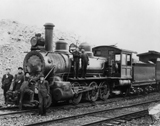Crowsnest Pass Spur Lines
“Frank and Grassy Mountain Railway”
The Turtle Mountain slide on April 29, 1903 covered a portion of the track, which was relocated by August.4 Fleutot and Remey were forced to find additional investment capital for further development and a new company, West Canadian Collieries, was incorporated in 1904. The company took over United Gold Fields, and established mines at Bellevue (1904) and Blairmore (1909).5 At Lille, Belgium “Bernard” type coke ovens, unique to Canada, were built.6 The decline in markets and the increased costs of mining led to the closure of operations in 1912.7
Hillcrest Coal and Coke Company
In 1902, C.P. Hill, an American, obtained mineral and surface rights located in Township 7, Range 3, west of the fifth meridian.8 He established the Hillcrest Coal and Coke Company in 1905, and connected the mine property to the Canadian Pacific’s Crow’s Nest Branch with a short, standard gauge, railway.9 The coal was transported from the mine over a narrow gauge line to the top of the hill and lowered to the “main line” by two methods—“one a double track. . . and lowering gear system and one a Jeffrey retarding conveyor” to a tipple.10 The coal was excellent for use in locomotives and was used principally by the CPR.11 In 1910, under new management, the company was renamed Hillcrest Collieries12 and it was amalgamated with Mohawk Collieries in 1938–39.13 The Hillcrest operation was closed on December 1, 1939.14
Notes | Bibliography | Abbreviations
1. Dominion Statute, 61 Victoria, Chapter 49, 1898.2. Dominion Statute, 2 Edward VII, Chapter 110, 1902.
3. Provicial Archives of Alberta 77.237, Item 64, Mine Inspector’s letter 12.2 ’03.
4. PAA 77.237, Item 64, Mine Inspector’s letter 27.8 ’03.
4. Dominion Statute, 4 Edward VII, Chapter 110, 1904; S. Babaian, compiler, The Coal Mining Industry in the Crow’s Nest Pass, Historic Sites Service, Alberta Culture (Edmonton: Alberta Culture, 1985), p. 13.
6. Crowsnest Historical Society, Crowsnest and its People, p. 121.
7. Alberta Department of Public Works, 1912; Crowsnest Historical Society, Crowsnest and its People, p. 121.
8. Babaian, The Coal Mining Industry, p. 22, Footnote 17: Box 20, File 1984, CPR Papers, GAI, p. 115.
9. Crowsnest Historical Society, Crowsnest and its People, p. 213.
10. Ibid.
11. Ibid.
12. Ibid.; Alberta Department of Public Works, 1910.
13. Babaian, The Coal Mining Industry, p. 98.
14. Crowsnest Historical Society, Crowsnest and its People, p. 223.


